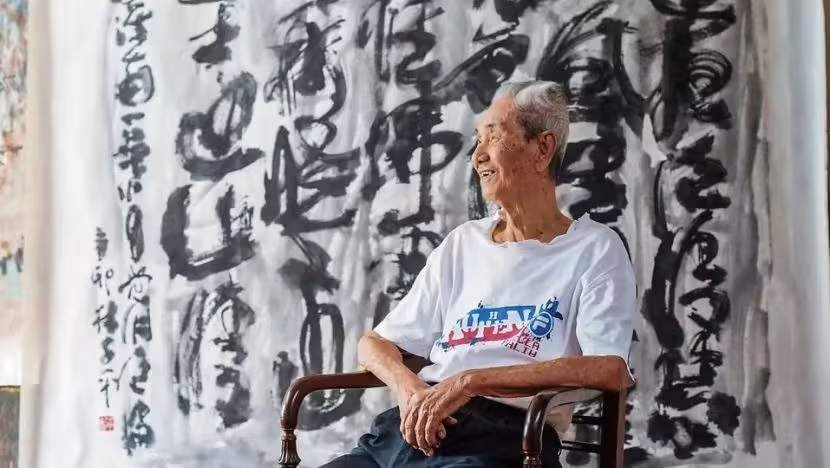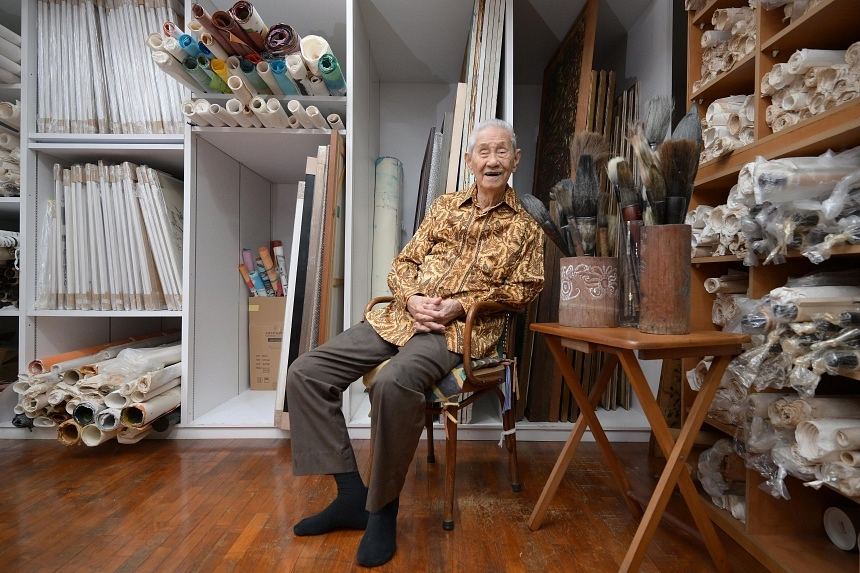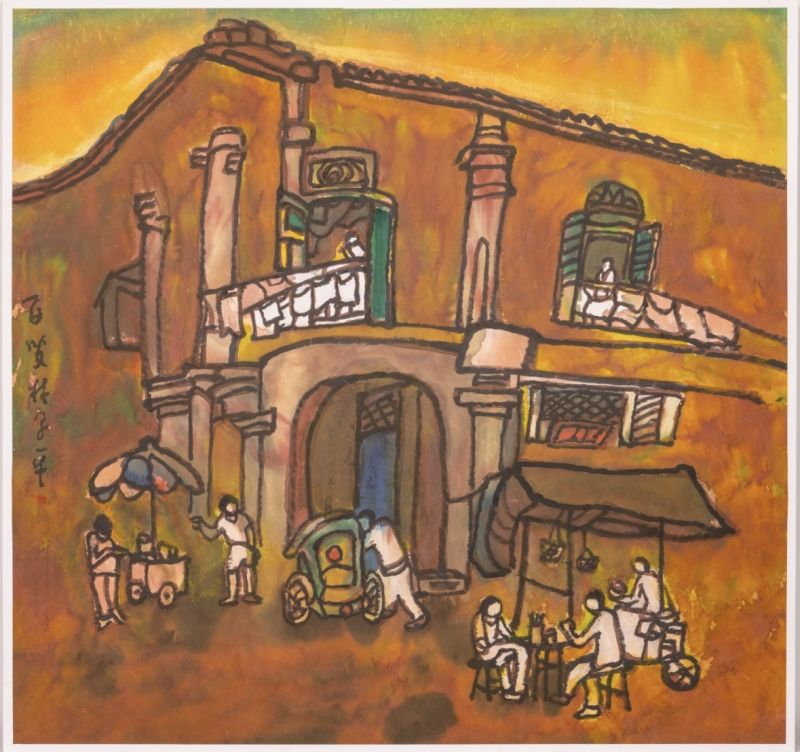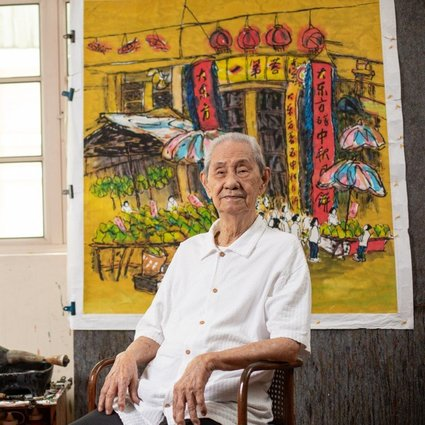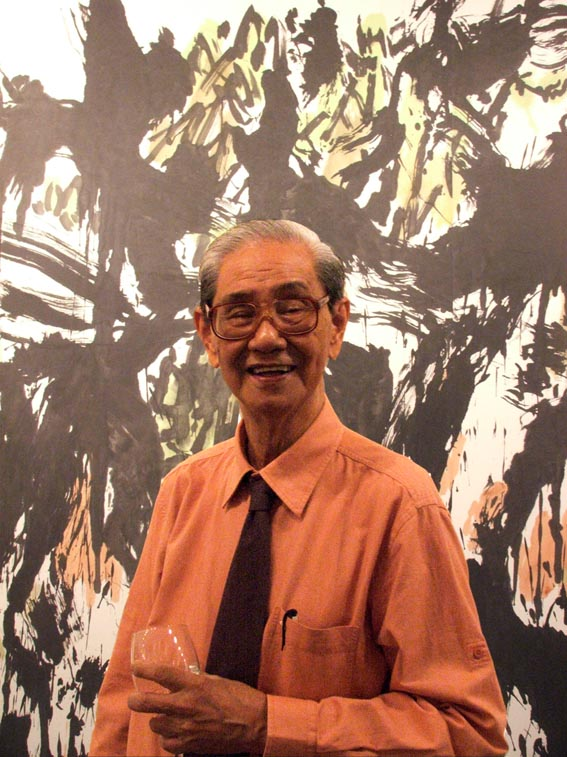Update 3 Feb 2025: Singapore's oldest artist Lim Tze Peng dies aged 103
Singapore's oldest artist Lim Tze Peng has died aged 103. The recipient of the Cultural Medallion in 2003, Mr Lim started painting in the 1950s when he was a teacher.
According to the National Library Board's (NLB) Infopedia, his paintings are often deeply rooted in tradition but "exude a contemporary feel at the same time". Prime Minister Lawrence Wong on Monday night (Feb 3) paid tribute to Mr Lim, calling him one of Singapore's "most significant artists". "Renowned for his ink paintings of old Singapore, he captured the spirit of a rapidly evolving nation through his art," Mr Wong said in a Facebook post, adding that Mr Lim's contributions to Singapore's cultural landscape are "immeasurable".
"He painted daily – even in his later years – attributing his longevity to this unwavering passion for creativity. "My heartfelt condolences go out to his family and loved ones during this time of loss. May they find comfort in knowing that his legacy will live on, continuing to inspire generations through the beauty and soul of his work."
DPM Heng Swee Keat at the Opening of the Becoming Lim Tze Peng Exhibition on 24 Oct 2024
A very good evening to all of you. I am very happy to join all of you this evening to celebrate a very distinct icon of Singapore's art scene. Indeed, the works of Mr Lim Tze Peng have not only captured the essence of our nation building, but also captured the hearts of art lovers around the world.
“Becoming Lim Tze Peng” is the National Gallery’s first solo exhibition dedicated to Mr Lim’s works and celebrates his significant contributions to the visual arts scene. The Chinese title 我画故我在 means "I paint, therefore I am". Just like René Descartes's philosophy "I think, therefore I am" – this emphasises the deep twining of the artist's identity and his art.
Mr Lim’s unique art style reflects his life experiences, and brings together traditional and modern techniques including calligraphy, epigraphy, ink painting, oil painting, and poetry. His iconic depictions of Singapore’s streetscapes, such as Chinatown and the Singapore River, and the vibrant hawker culture during that time chronicle our nation's transformation and form an important part of our unique cultural heritage and identity. For my generation, these pieces immortalise our reminiscence of the charms of an earlier era.
‘Art has given me longevity’: Lim Tze Peng, 103, ebullient about National Gallery solo exhibition
Artist Lim Tze Peng at his house & studio in Telok Kurau ahead of his first solo exhibition at the National Gallery S'pore
At 103, Singaporean artist Lim Tze Peng has distilled his daily life to three essentials. He eats, he sleeps and, without fail, he picks up his brush to paint. “Art has given me longevity,” says the Cultural Medallion recipient, whose booming voice echoes through his three-storey home and studio in Telok Kurau. “Making art every day is like exercising daily – my arms go up and down, left and right. Because of art, I am rarely ill. Whenever I feel a little sick, I’ll just go bask in art.
“There’s not a single day that I do not paint or write calligraphy,” declares Lim, fresh from an afternoon nap, when he appears in his studio with ink stains on his brown pants. Throughout the 40-minute interview with The Straits Times, he is excitable and ebullient about the fact that his first major institutional show locally since 2003 opens on Oct 25. Becoming Lim Tze Peng, his first solo exhibition at the National Gallery Singapore, is a small but substantial exhibition of the artist’s works from 1946 to 2023. It begins with his signature Singapore scenes and quickly broadens its ambit to reveal different facets of a man who can be said to have lived a myriad of long lives, in and out of art.
Born in 1921 in a kampung in Pasir Ris, Lim recalls a childhood of poverty, when he manually extracted oil from more than a hundred coconuts every day to sell. Then, at school, his hands turned to Chinese ink, and his precocious talent was spotted by some of his first teachers – Wong Jai Ling, Yeh Chi Wei and Liu Kang, among others. Lim recounts in Mandarin: “After class, I would run to the Singapore River to paint the boats. My teachers would close their doors when they were painting, but I would still try to peek in from the outside and watch.” “Whenever I am near a painting, I get very excited and serious,” he says with a chuckle.
Lim Tze Peng: Chronicling Singapore’s evolution – and his own – through Chinese ink
Lim Tze Peng's iconic 1979 ink painting "Singapore River (Coleman Bridge)" captures not just the physical landscape but the soul of the city in flux
A curated selection traces the progression of his artistic style as well as that of his country, from rustic kampungs to a bustling city
AT 103 years of age, the still-active artist Lim Tze Peng has created a body of work that’s possibly larger than that of any other Singaporean artist – with one estimate putting his output at around 20,000 pieces. Opening this week, his first solo exhibition at National Gallery Singapore has only about 50 works dated from 1946 to 2023. It is thus a small sampling of an extensive oeuvre that has outlived multiple eras of Singapore’s transformation, from its pre-independence days to its rise as a wealthy metropolis.
Lim’s art chronicles this remarkable journey. His early Chinese ink paintings capture the rustic charm of old Singapore – the kampungs, the Singapore River and bustling street markets – before the rapid urbanisation that followed. As Singapore evolved, so did his artistic expression, moving from detailed representational works to more abstract and expressive forms, particularly in his calligraphy. His brushstrokes, once depicting scenes of daily life, now embody a deep, almost spiritual reflection on change, memory and identity.
103-year-old S'porean artist Lim Tze Peng opens permanent gallery at Ubi
Local artist Lim Tze Peng turned 103 on 28 Sep 2024. Alongside his birthday celebration, Lim opened the first permanent gallery for his artworks named "The Art Abode: Lim Tze Peng".
Emeritus Senior Minister Goh Chok Tong was the guest of honour at the gallery launch and birthday celebration. Low Sze Wee, CEO of Singapore Chinese Cultural Centre and curator for the exhibition, said that it has been a lifelong dream for Lim to have a space where he can share his art with the public.
Lim was a recipient of the Cultural Medallion in 2003, and many of his works are displayed in the National Gallery and the Singapore Art Museum, as well as part of many prestigious collections. The works were selected to showcase Lim's artistic range and versatility over the years, said Low. On the ground floor, his paintings depict local scenes like Chinatown, Singapore River and kampungs. Some of them are oil paintings he made his early career, before the 1980s when he started focusing on making the ink paintings that he is well known for.
Lim Tze Peng
Born in Singapore in 1921, Lim Tze Peng is one of Singapore’s most significant artists and a living legend.
Renowned for his Chinese ink creations of post-independence Singapore, he also practices Chinese calligraphy. Alongside local and international exhibitions, his masterpieces are exhibited in prominent Singapore institutions and part of many prestigious collections.
Lim has been bestowed several awards including the Special Prize at the Commonwealth Art Exhibition in England in 1977 and the prestigious Cultural Medallion in Singapore in 2003. In May 2012, he broke records with the sale of his works at a Christies auction in Hong Kong.
Lim Tze Peng 林 子 平
On September 28, 1921, Lim Tze Peng, a second-generation Nanyang style artist, was born in Singapore. His bright Chinese ink drawings of ancient Singapore, particularly of old Malay kampongs, Chinatown, and the Singapore River, are his most well-known works.
Over the course of his six-decade career as an artist, the ex-schoolteacher and self-taught artist has created a vast body of work that includes oil, Chinese ink, and, most recently, reimagined calligraphic paintings that show the artist’s progression from realism to ferocious expressionism, all while painting an evocative and delicate tale of Singapore’s past as seen by the common man. In 2003, he received the Cultural Medallion for his contributions to the visual arts in Singapore.
Lim Tze Peng taught himself to paint as a child. Since he was passionate about his hobby, he painted still lifes in watercolours and oils. In 1949, he graduated from Chung Cheng High School and went on to teach at Sin Min School, a primary school in Pasir Ris at the time. In 1951, he became the principal of Sin Min School, where he stayed until 1981, when he retired. Lim was a committed student who spent his academic career pursuing his passion for painting.
Lim Tze Peng
This is a headshot photograph of Lim Tze Peng, recipient of the Cultural Medallion in 2003. He first established his art practice in the early 1950s with a series of oil painting on Chinese junks. He is best known for the significant number of Chinese ink drawings and paintings of Chinatown and the Singapore River he produced during the early 1980s when urban redevelopment focused on these two areas. Having a solid foundation in Chinese philosophy, art and culture, Tze Peng also practised Chinese calligraphy, especially in the 1990s. Title devised by Library staff.
Lim Tze Peng (林子平) (b. 28 September 1921, Singapore–) is an artist, and a winner of the Cultural Medallion in 2003.2 Self-taught, Lim started painting in the 1950s when he was a teacher in Xin Min School.3 Having a strong foundation in Chinese philosophy, art and culture, Lim’s paintings are often deeply rooted in tradition, and yet exude a contemporary feel at the same time. The eldest of seven children, Lim was born in 1921 in a kampong in Pasir Ris. His parents were farmers who reared pigs and chickens and tapped rubber trees.
Lim was educated at Guangyang Primary School and Chung Cheng High School. It was during this period when his love for Chinese calligraphy and oil painting was cultivated under the tutelage of art teachers such as Lu Heng, Gao Peize, Wong Jai Ling and Yeh Chi Wei. In calligraphy, Lim was much influenced by master calligrapher, Kang Youwei, and Kang’s discussion of the aesthetics of Chinese calligraphy in one of his works, Guang Yi Zhou Shuang Ji (《广艺舟双楫》). Lim’s ink paintings, on the other hand, were heavily influenced by Huang Bin Hong. Lee took up teaching in Xin Min School in 1949. He became the school’s principal in 1951 and remained in the position until 1981.
Lim Tze Peng
Lim Tze Peng (Chinese: 林子平; pinyin: Lín Zǐpíng; Pe̍h-ōe-jī: Lîm Tsí-pîng, born 28 September 1921) is a Singaporean artist who is a teacher by training and profession. He was awarded a Cultural Medallion in 2003 in recognition of his contribution to the country's art and culture. In June 2021, it was reported that he was still producing art at the age of 99.
Lim Tze Peng (Lim Swee Lian) was born on 28 September 1923, Singapore, to a family of pig and chicken farmers in Pasir Ris. He is the eldest of seven children. Lim Tze Peng studied at Guangyang Primary School and Chung Cheng High School.
In 1949, Lim Tze Peng became a primary school teacher at Xin Min School and then became principal in 1951. He remained as principal till he retired in 1981.
Lim Tze Peng is humble by nature and goes about in his quiet way doing what he loves best without fanfare. He is content to stay in the background, preferring his paintings speak for themselves. He is a true artist, one who is not publicity-conscious. He is also an artist with a mission, and that mission is to remind Singaporeans of their heritage.
